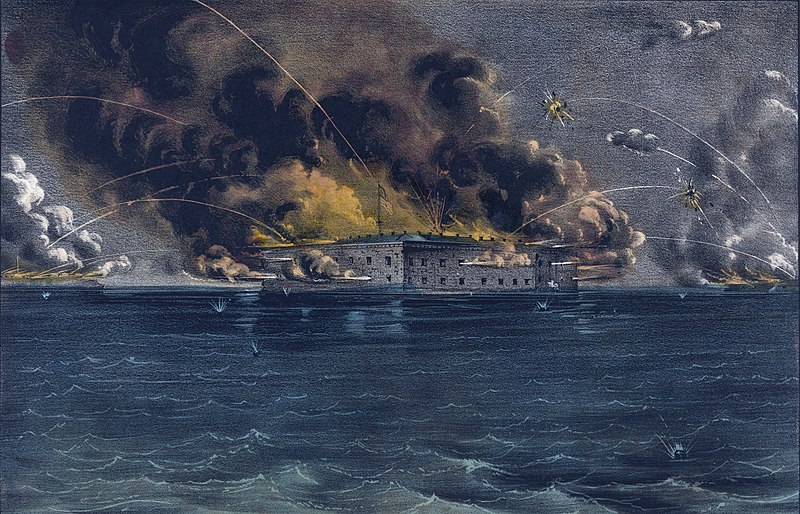The Battle of Fort Sumter was a military engagement that took place at the beginning of the American Civil War. It was fought on April 12-13, 1861, at Fort Sumter, a sea fort located in the harbor of Charleston, South Carolina.
The fort was held by a small force of Union soldiers, who had been sent to defend the federal property in the Southern state.
The Confederate States of America, which had seceded from the Union and formed its own government, demanded that the Union troops vacate the fort. When the Union refused, Confederate forces began bombarding the fort.
Also Read: Civil War Battles
After the battle, Union forces launched a series of offensives in the South, while the Confederacy focused on building up its military capabilities. The Civil War would drag on for four more years, with numerous battles and campaigns fought on both sides.
Battle of Fort Sumter Facts
1. No One was Killed at Fort Sumter
After a 34-hour bombardment, the Union soldiers at the fort were forced to surrender. No one was killed in the battle, but the incident marked the beginning of the Civil War, which would claim the lives of more than 600,000 Americans.
The Union Army returned fire and held out against the Confederate attack for 34 hours before being forced to surrender the fort on April 13.
2. First Major Battle in the Civil War
The Battle of Fort Sumter was a significant event in the Civil War because it marked the first time that military action was taken against the Union.
It also demonstrated the determination of the Confederacy to defend its sovereignty and the willingness of the Union to fight to preserve the unity of the country.
Also Read: Facts About the Battle of Shiloh
The Battle of Fort Sumter was the first military engagement of the American Civil War, and it marked the beginning of a long and bloody conflict that lasted for four years.
3. Major Robert Anderson was in Command of the Fort
The Union Army, led by Major Robert Anderson, was occupying Fort Sumter, a strategically important fort located on an island in the harbor.
4. First Time Americans Took Up Arms Against Each Other
The battle was significant because it marked the first time that American soldiers had fought against each other in a major military engagement.
5. Victory for the Confederacy
As a single engagement the Battle of Fort Sumter was a victory for the Confederacy and a significant defeat for the Union.
However, the battle did not result in a decisive victory for either side, as the Union retained control of several other forts in the harbor and the Confederacy did not achieve its main objective of driving the Union out of Charleston.
6. First Ever Defeat for the Union Army
The Union Army’s surrender of the fort was a major blow to Northern morale, as it marked the first time that the Union had been defeated in a military engagement.
7. No Casualties But Some Injuries
The Union Army suffered no casualties during the battle, while the Confederacy suffered four wounded soldiers.
There were no casualties on either side during this engagement, however two U.S. Army soldiers were killed in a gun explosion during surrender ceremonies on April 14. One week later, on April 5, 1861, there was a riot in Baltimore that has come to be known as the “First Bloodshed of the Civil War.”
8. P. G. T. Beauregard Commanded the Confederate Army
As the first general officer of the newly established Confederate States Army, Brigadier General P. G. T. Beauregard was given command of Confederate forces in Charleston in March. Beauregard led the reinforcement of the batteries around Charleston harbor, which were targeted at Fort Sumter, with great vigor and determination.
9. It Is Now A Major Tourist Attraction
Today, the Battle of Fort Sumter is remembered as a significant event in American history, and the fort is a popular tourist attraction in Charleston, South Carolina.
10. First Crisis of the Administration of U.S. President Abraham Lincoln
U.S. President Abraham Lincoln was sworn into office on March 4, 1861, following his electoral victory on November 6, 1860. The resupply of Fort Sumter became the first problem of Lincoln’s administration.
He informed South Carolina Governor Francis W. Pickens that he was sending supply ships, prompting the Confederate administration to issue an ultimatum demanding the immediate evacuation of Fort Sumter. Major Anderson refused.
11. Heated Canon Balls Were Used
While Sumter was made of stone, its barracks and officers’ apartments were housed in timber structures.
The Confederates fired heated shot (cannonballs cooked to a red heat in a furnace) at them, potentially setting out fires that would be more harmful to the men than the explosive artillery rounds.
At 7 o’clock on the evening of April 12, the fires were doused by a rainstorm, and the Union gunners ceased shooting for the night.
12. Resulted In More Southern States Joining the Confederacy
After the conflict, there was strong support from both the North and the South for additional military action to be taken. In response to Lincoln’s urgent request for 75,000 volunteers to put down the insurrection, four further Southern states declared their independence from the Union and joined the Confederacy.
13. Union Eventually Retook Fort Sumter
The Union Army was eventually able to recapture Fort Sumter in 1865, near the end of the Civil War.
